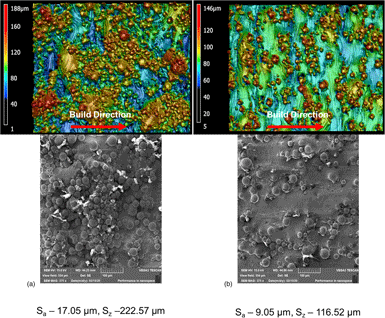Crossref Citations
This article has been cited by the following publications. This list is generated based on data provided by
Crossref.
Enrique, Pablo D.
Keshavarzkermani, Ali
Esmaeilizadeh, Reza
Peterkin, Stephen
Jahed, Hamid
Toyserkani, Ehsan
and
Zhou, Norman Y.
2020.
Enhancing fatigue life of additive manufactured parts with electrospark deposition post-processing.
Additive Manufacturing,
Vol. 36,
Issue. ,
p.
101526.
Kasperovich, Galina
Becker, Ralf
Artzt, Katia
Barriobero-Vila, Pere
Requena, Guillermo
and
Haubrich, Jan
2021.
The effect of build direction and geometric optimization in laser powder bed fusion of Inconel 718 structures with internal channels.
Materials & Design,
Vol. 207,
Issue. ,
p.
109858.
Berdanier, Reid A.
Fishbone, Scott
Thole, Karen A.
Brogan, Jeffrey
Mantese, Joseph V.
Martin, Thomas J.
Caldwell, Dustin
Kulkarni, Anand
Subramanian, Ramesh
Emerson, Benjamin L.
and
Lieuwen, Timothy C.
2021.
Sensor Integration on Additively Manufactured Hot Section Components for Wireless Gas Turbine Prognostics.
Ertay, Deniz Sera
Naiel, Mohamed A.
Vlasea, Mihaela
and
Fieguth, Paul
2021.
Process performance evaluation and classification via in-situ melt pool monitoring in directed energy deposition.
CIRP Journal of Manufacturing Science and Technology,
Vol. 35,
Issue. ,
p.
298.
Emminghaus, Nicole
Hoff, Christian
Hermsdorf, Jörg
and
Kaierle, Stefan
2021.
Residual oxygen content and powder recycling: Effects on surface roughness and porosity of additively manufactured Ti-6Al-4V.
Additive Manufacturing,
Vol. 46,
Issue. ,
p.
102093.
McGregor, Martine
Patel, Sagar
McLachlin, Stewart
and
Mihaela Vlasea
2021.
Architectural bone parameters and the relationship to titanium lattice design for powder bed fusion additive manufacturing.
Additive Manufacturing,
Vol. 47,
Issue. ,
p.
102273.
Ghosh, Abhi
Kumar, Amit
Joy, Nithin
Kietzig, Anne-Marie
and
Brochu, Mathieu
2021.
Characterization of femtosecond laser micromachined specimens extracted from PBF-LB/M microstruts: Analyzing surfaces fabricated via internally linked machined kerfs.
Materialia,
Vol. 20,
Issue. ,
p.
101260.
Ghosh, Abhi
Kumar, Amit
Wang, Xianglong
Kietzig, Anne-Marie
and
Brochu, Mathieu
2022.
Analysis of the effect of surface morphology on tensile behavior of LPBF SS316L microstruts.
Materials Science and Engineering: A,
Vol. 831,
Issue. ,
p.
142226.
Cabrini, M.
Carrozza, A.
Lorenzi, S.
Pastore, T.
Testa, C.
Manfredi, D.
Fino, P.
and
Scenini, F.
2022.
Influence of surface finishing and heat treatments on the corrosion resistance of LPBF-produced Ti-6Al-4V alloy for biomedical applications.
Journal of Materials Processing Technology,
Vol. 308,
Issue. ,
p.
117730.
Patel, Sagar
Chen, Haoxiu
Vlasea, Mihaela
and
Zou, Yu
2022.
The influence of beam focus during laser powder bed fusion of a high reflectivity aluminium alloy — AlSi10Mg.
Additive Manufacturing,
Vol. 59,
Issue. ,
p.
103112.
Ghosh, Abhi
Kumar, Amit
Harris, Adrian
Kietzig, Anne-Marie
and
Brochu, Mathieu
2022.
Fatigue behavior of stainless steel 316L microstruts fabricated by laser powder bed fusion.
Materialia,
Vol. 26,
Issue. ,
p.
101591.
Wirths, Laura
Bleckmann, Matthias
Lurtz, Patrick
Paetzold, Kristin
and
Höfer, Philipp
2023.
Innovative Product Development by Additive Manufacturing 2022.
p.
47.
Pourrahimi, Shamim
Hakimian, Soroosh
Bouzid, Abdel-Hakim
and
Hof, Lucas A.
2023.
On the Use of Machine Learning Algorithms to Predict the Corrosion Behavior of Stainless Steels in Lactic Acid.
Metals,
Vol. 13,
Issue. 8,
p.
1459.
Zhang, Kevin
Hickey, Jean-Pierre
and
Vlasea, Mihaela
2023.
An Analysis Framework of Additively Manufactured Deterministic Porous Structures for Transpiration Cooling.
Journal of Materials Engineering and Performance,
Vol. 32,
Issue. 20,
p.
9253.
Bhatt, Alisha
Huang, Yuze
Leung, Chu Lun Alex
Soundarapandiyan, Gowtham
Marussi, Sebastian
Shah, Saurabh
Atwood, Robert C.
Fitzpatrick, Michael E.
Tiwari, Manish K.
and
Lee, Peter D.
2023.
In situ characterisation of surface roughness and its amplification during multilayer single-track laser powder bed fusion additive manufacturing.
Additive Manufacturing,
Vol. 77,
Issue. ,
p.
103809.
Issariyapat, Ammarueda
Huang, Jeff
Teramae, Takuma
Kariya, Shota
Bahador, Abdollah
Visuttipitukul, Patama
Umeda, Junko
Alhazaa, Abdulaziz
and
Kondoh, Katsuyoshi
2023.
Microstructure refinement and strengthening mechanisms of additively manufactured Ti-Zr alloys prepared from pre-mixed feedstock.
Additive Manufacturing,
Vol. 73,
Issue. ,
p.
103649.
Mingear, Jacob
Zhang, Bing
Elwany, Alaa
and
Hartl, Darren
2023.
Roughness Analysis of Powder-Bed Fused Nickel–Titanium Surfaces with Chemical Etching Enhancement by a Safe Aqueous Fluoride Solution.
Shape Memory and Superelasticity,
Vol. 9,
Issue. 3,
p.
504.
Bernard, Alain
Kruth, Jean-Pierre
Cao, Jian
Lanza, Gisela
Bruschi, Stefania
Merklein, Marion
Vaneker, Tom
Schmidt, Michael
Sutherland, John W.
Donmez, Alkan
and
da Silva, Eraldo J.
2023.
Vision on metal additive manufacturing: Developments, challenges and future trends.
CIRP Journal of Manufacturing Science and Technology,
Vol. 47,
Issue. ,
p.
18.
McGregor, Martine
Patel, Sagar
Zhang, Kevin
Yu, Adam
Vlasea, Mihaela
and
McLachlin, Stewart
2024.
A Manufacturability Evaluation of Complex Architectures by Laser Powder Bed Fusion Additive Manufacturing.
Journal of Manufacturing Science and Engineering,
Vol. 146,
Issue. 6,
Pourrahimi, Shamim
and
Hof, Lucas A.
2024.
On the Post‐Processing of Complex Additive Manufactured Metallic Parts: A Review.
Advanced Engineering Materials,
Vol. 26,
Issue. 10,




